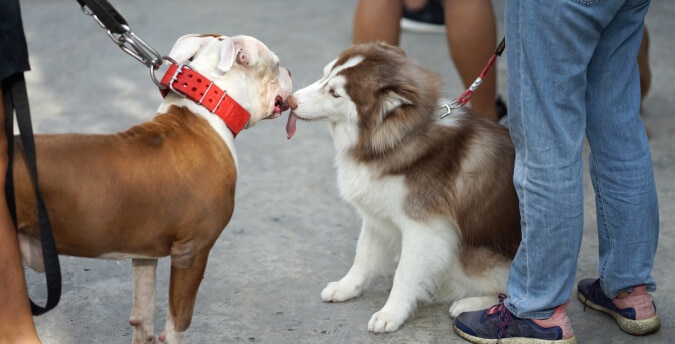Tips For Teaching Your Dog To Meet Other Dogs

Socializing your dog with other dogs is important if you want to be able to go out to the dog park. The problem is that a lot of dogs do not naturally know how to successfully meet other dogs. This is where you as their owner will come in. There are a number of tips that you can use to teach your dog how to properly greet and socialize with other dogs.
KNOW YOUR DOG’S BODY LANGUAGE
As your dog is unable to verbally tell you what they are feeling, you need to become an expert in their body language. Dogs will use their whole bodies to communicate and you can tell how they feel in any situation. Meeting new dogs can be stressful for some dogs while others will be very happy about this and their body language will tell you about this.
If your dog is showing signs of fear when they meet a new dog, you will want to cut that meeting short. Fear responses will often be linked to shivering and your dog cowering from the other dog. If your dog’s ears are flat, they could be feeling threatened and want to attack. This is something to look for as you do not want your dog to attack another person’s pet.
HAVE A FIRM GRASP ON THEIR HARNESS
When your dog is meeting another dog, you should have a firm grasp of their leash or harness. This will help you maintain control of the situation. If your dog has a bad reaction to meeting the other dog, you will be able to pull them away quickly.
Being able to pull away is also important when the other dog does not know how to greet correctly. You do not want your dog to be in a position where they feel intimidated by the other dog. However, if the dogs start to fight, you should not put your hand by their collar as this will result in a bite. You should try to distract the dogs or get a barrier between them. If this does not work, you and the other owner should pull the dogs away from each other using their back legs.
STAY ON NEUTRAL GROUND
When you are teaching your dog to meet other dogs, you need to ensure that you are on neutral ground. This is something that you should continue even after training your pet. Neutral ground is important because it will prevent any territorial behaviors which could turn south very quickly.
The dog park is one of the best neutral areas to head to when training your pet. There are a lot of other dogs around for them to meet and none of them have a claim to the area. Pet stores and even the pavement outside your home will also work as a neutral area.
ALLOW ENOUGH SPACE FOR GREETING
A lot of people make the mistake of keeping a short leash when they teach their dog to meet others. This is a mistake because your dog will not actually have enough space to properly greet the other dog. Friendly dog greetings will involve the animals circling each other in a loose manner. There will also be a lot of wiggling body language.
This is why you need to have a loose leash when your pet meets other dogs. If they are unable to curve their body and wag their tails freely, they will not be able to greet correctly. Having a short leash could give your dog the wrong impression and make them think you do not want them greeting the other dog.
STAY CALM AND RELAXED
When it comes to meeting another dog, you need to stay calm and relaxed. If you start to tense, your dog is going to sense this and they will start to get tense. By remaining calm, you are reassuring your pet that there is nothing to be afraid of.
While you need to be an expert at reading your dog’s body language, your pet is going to be able to read your body language. Any hint of nerves on your part will put them on edge. They will not know why you are nervous and could start to think the worst of the approaching dog.
HAVE TREATS ON HAND
Treats are a great way to positively reinforce behavior. Having some on hand when you meet other dogs will also help you teach your pet. When your dog has a successful meeting with another dog, you should give them a treat.
Praising them will also work, but a lot of dogs are motivated by food. If your dog has a bad interaction with another dog, you should not treat them because this could reinforce the wrong kind of behavior even if the problem was with the other dog.
